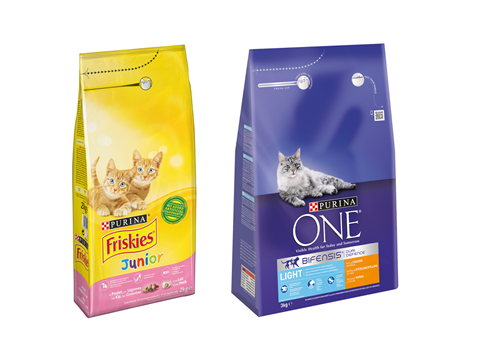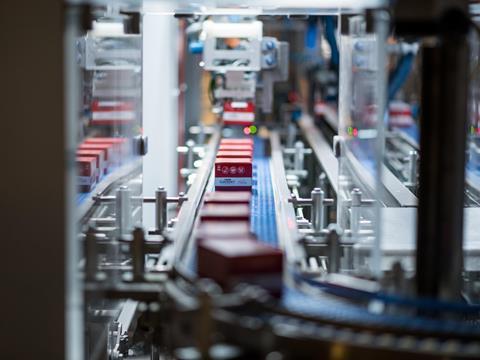
Mirroring trends in many other CPG market segments, the pet food market has undergone growth and stratification in recent years, giving rise to new opportunities for packaging to add value. Bernard Meunier, CEO of Nestlé Purina PetCare EMENA, shared his story of sustainability, premiumisation and digitisation in the market with (cat owner) Tim Sykes.
The Purina brand offers pet food and care products for cats and dogs, including a range of specialised veterinary pet food for dogs and cats, and several sub-brands sold within individual countries. The portfolio comprises dry food, packaged in paper-based boxes and paper or plastic bags, wet food in plastic/aluminium pouches and cans, and snacks, which are packaged in plastics.
Given the importance of cats and dogs to their owners, should we really think of pet food packaging as a subset of food packaging, with all the functional demands and quality standards this implies?
“At Purina, having the right packaging is crucial for delivering safe, high quality pet food to our consumers and their pets, as well as reducing food waste,” Bernard remarks. “Most of our packaging formats are designed to store the product after it’s been cooked, e.g. flow wraps, bags, stand up bags and boxes. However, pet food that is supplied in plastic/aluminium composite pouches is sealed and cooked when it is already in the pouch – making the role of the pouch different to most other packaging.”
Metamorphosing market
The segment has been disrupted in recent years by a number of new trends that would be largely familiar to those following the market for (human) food. “We have seen new evolving food philosophies such as natural ingredients and alternative proteins, and generally a greatly increased expectation that industry should be a force for good,” says Bernard. “Meanwhile, new data powered business models are emerging, along with new sources of trusted advocacy and influence, digitally connected pet health services are flourishing, and there’s an acceleration of direct-to-consumer personalised models. Through disruption, new opportunities appear: unlimited opportunities to create new value streams, by delivering outstanding experiences for tomorrow’s pet owners.”

A perhaps more visible trend in pet-care is premiumisation – which is itself driven by factors such as customisation through e-commerce and the new dietary philosophies referenced by Bernard. He cites the examples of Terra Canis and tails.com. Terra Canis is an ultra-natural pet food company with unique expertise in the premium natural pet food market. Meanwhile, tails.com is Europe’s most advanced player in the direct-to-consumer, tailor-made pet food category and is growing very strongly.
“They have a unique and winning business model that successfully combines individually customised recipes with a best in class pet owner experience at competitive prices,” Bernard comments. “Consumer demand continues to grow for personalised products and services. Purina has invested in both brands as part of our steps in building an ecosystem with partners and experts who help promote pet health and pet wellbeing.”
Taking responsibility
While these trends are typically reflected in value-added packaging, the number one issue on the packaging agenda is inevitably environmental impact. Purina’s latest analysis of the most important issues for EMENA stakeholders emphasises sustainability in two of its four pillars (namely, promoting loving and responsible pet ownership; working with others to address scarcity of resources; demonstrating radical transparency; and reducing environmental inputs and outputs). These filter through to specific commitments to improve the environmental performance of Purina’s packaging. These include aiming to avoid the use of 3000 tonnes of packaging material by 2019 compared to 2015 levels – a goal which has been surpassed by 18 per cent. Of the packaging material saved, 52 per cent was plastic.
“Plastics offer a unique combination of durability, availability, hygiene and safety, making it an ideal packaging material,” Bernard remarks. “The properties of plastic also provide a lot of flexibility and freedom in design, whilst being lightweight but strong, enabling packaging to be tailored to the product. There has been considerable progress in ensuring the use of only a minimum adequate amount of plastic packaging to pack products safely, and the recovery of plastic at the end of its useful life.”
Indeed, circularity is a central focus of Purina’s strategy, in line with its parent company’s commitments. In April 2018 Nestlé made a global commitment that by 2025 100 per cent of its packaging (including all Purina products) will be reusable or recyclable. Furthermore, in January 2019 Nestlé announced a series of specific actions towards meeting this commitment, with a particular focus on avoiding plastic-waste.

“At Purina, we share the Nestlé vision that no packaging ends up as waste and are ready to play our part to help achieve the 2025 commitment,” Bernard continues. “For most packaging applications, recycling is likely to be the preferable end of life pathway as it keeps materials circulating within the economy and currently 67 per cent of our packaging is widely recyclable. However, for some applications we are also exploring possibilities to have our packaging made from compostable materials.”
Low-hanging fruit and beyond
Some of the environmental savings have been achieved by optimising multi-packs and traditional downgauging. For instance, in 2018 Purina made adjustments to the aggregation of its PURINA® GOURMET™ 50 g pouches and 85 g cans. Changes in cardboard specification facilitated savings of 140 tonnes of packaging in can multi-packs. As for for pouch multi-packs, Purina installed a new packaging line and changed the outer structure, enabling a reduction in the material used from 30.5 g to 26.1 g – contributing savings of 99 tonnes overall.
Meanwhile, reduction in use of plastics has been achieved thanks to downgauging the PE layer: on the Duplex dry laminates (FRSK) Purina has downgauged the PE layer from 100 to 75 microns and on the triplex laminates (ONE) from 75 to 60 microns.
As for recyclability, if 67 per cent of Purina packaging is currently widely recycled, of the remainder 27 per cent is deemed ‘hard to recycle’, and the final six per cent has ‘limited recyclability’. Inevitably, the aluminium/plastic composite wet food pouches represent one of the most difficult challenges. “It’s difficult to separate the individual layers for recycling and there are very few recycling facilities who can currently do this,” says Bernard. “At the same time, each country differs in their ability to collect sort, re-use, recycle and recover packaging.
“We are working on reducing both the complexity of materials and number of different layers in our packaging. This will make the packaging easier to recycle. In relation to this, we are working hard to find an alternative material for pet food pouches. It is not easy because pouch packaging needs to be robust enough both to withstand our cooking processes and to keep the product fresh on shelf. Nevertheless, and since one of our priorities is to make Purina wet food pouches fully recyclable, our teams are testing new design and technologies, which would ensure circularity of the pouch.”
The pouch predicament
Purina believes that with the right materials, collection and recycling in place, the continued use of pouch packaging for pet food is possible without causing a detrimental effect on the environment. “The durable properties of plastics mean that when treated and processed properly, plastics can be reused or recycled, in a closed loop,” Bernard suggests. “But to achieve this, in addition to working on design for recycling on our part, collaboration and collective action is vital for transforming how packaging is managed today. We recognise that the 2025 commitment is a difficult journey. Recognising this, we are working with value chain partners and industry associations to identify solutions as quickly as possible.”
Purina is for instance participating in CEFLEX, on whose work toward an infrastructure to collect, sort and recycle all types of used flexible plastics across Europe by 2025 we have reported extensively.
“There is also a partnership between Nestlé and Veolia, the world’s leading resource management company, to work on waste collection, sorting and recycling of plastic material, with a particular emphasis on flexible plastic packaging,” says Bernard. “This partnership with Veolia follows a series of specific initiatives and steps to accelerate action to tackle plastic waste, in line with Nestlé's commitment to make 100 per cent of its packaging (including Purina products) recyclable or reusable by 2025.”
Progress on its recyclability and resource efficiency responsibilities will be essential for basic brand hygiene in the pet care market. But in a rapidly changing world with fast changing consumer expectations, competitive edge is likely to rely on more than sustainability. The direction of pet food packaging will also be determined by trends emerging today whose end-points we probably still cannot see. How will pet ownership change as ownership models are being radically rethought? As humans take an interest in vegetarian and vegan diets and unprocessed foods, will they explore similar options for their carnivorous pets? What degree of personalisation and how much supply chain transparency will the digital consumer expect of food that passes through their beloved pet’s lips? The answers to these questions, and how industry answers the sustainability question, will shape the cat and dog food packaging of tomorrow.

















